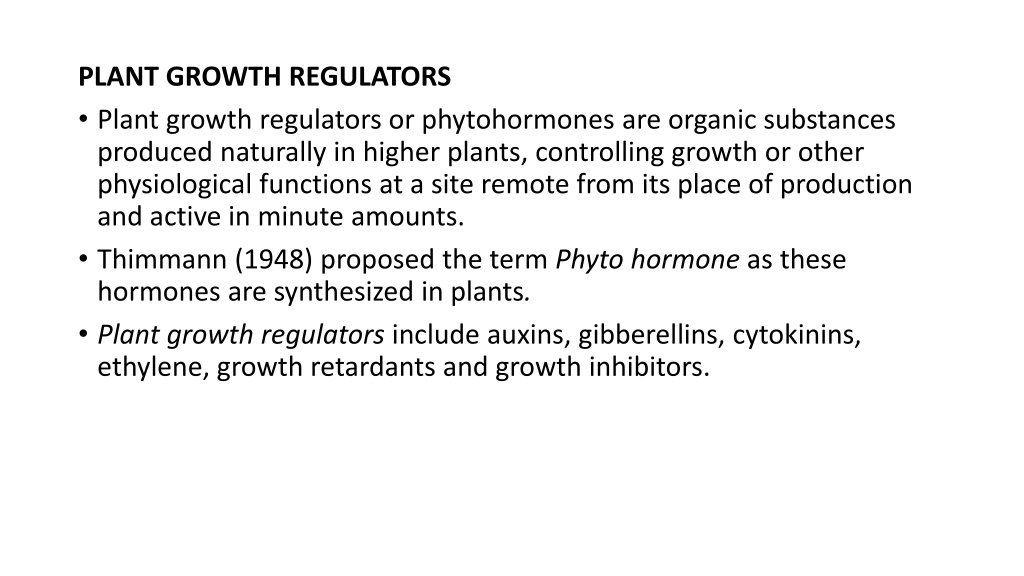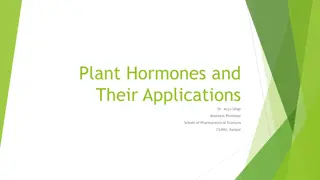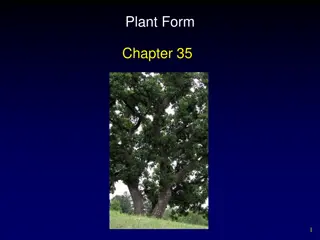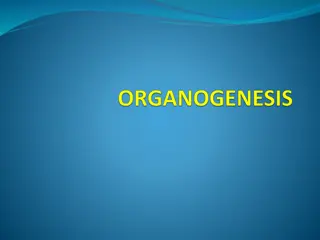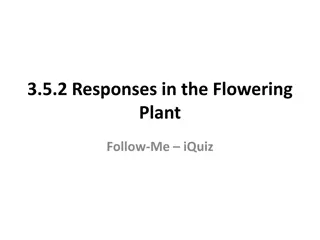Understanding Plant Growth Regulators: Phytohormones and Their Functions
Plant growth regulators, also known as phytohormones, are organic compounds produced naturally in plants to control growth and physiological functions. They include auxins, gibberellins, cytokinins, ethylene, growth regulators, and inhibitors. Auxins, for example, promote growth along the plant's longitudinal axis, affecting cell division, elongation, and apical dominance. These phytohormones play crucial roles in various plant processes and can be naturally occurring or synthetic compounds.
Download Presentation

Please find below an Image/Link to download the presentation.
The content on the website is provided AS IS for your information and personal use only. It may not be sold, licensed, or shared on other websites without obtaining consent from the author. Download presentation by click this link. If you encounter any issues during the download, it is possible that the publisher has removed the file from their server.
E N D
Presentation Transcript
PLANT GROWTH REGULATORS Plant growth regulators or phytohormones are organic substances produced naturally in higher plants, controlling growth or other physiological functions at a site remote from its place of production and active in minute amounts. Thimmann (1948) proposed the term Phyto hormone as these hormones are synthesized in plants. Plant growth regulators include auxins, gibberellins, cytokinins, ethylene, growth retardants and growth inhibitors.
Plant Hormone When correctly used, is restricted to naturally occurring plant substances, there fall into five classes. Auxin, Gibberellins, Cytokinin, ABA and ethylene. Plant growth regulator includes synthetic compounds as well as naturally occurring hormones.
Auxins Auxins are a group of phytohormones produced in the shoot and root apices and they migrate from the apex to the zone of elongation. Auxins promote the growth along the longitudinal axis of the plant and hence the name (Greek word auxein : to grow). The term, auxin was introduced by Kogl and Haagen- Smit (1931).
Auxin is generally produced by the growing tips of the stem and root, from where they migrate to the region of the action.. Indole Acetic Acid (IAA) is the only naturally occurring auxin in plants. The synthetic auxins include, IBA : Indole Butyric Acid NAA : Naphthalene Acetic acid MENA: Methyl ester of Naphthalene acetic acid MCPA: 2 Methyl 4 chloro phenoxy acetic acid TIBA : 2, 3, 5 Tri iodo benzoic acid 2, 4-D : 2, 4 dichloro phenoxy acetic acid 2, 4, 5-T: 2, 4, 5 Trichloro phenoxy acetic acid
Physiological effects of auxin 1. Cell division and elongation The primary physiological effects of auxin are cell division and cell elongation in the shoots. It is important in the secondary growth of stem and differentiation of xylem and phloem tissues.
2. Apical dominance In many plants, if the terminal bud is intact and growing, the growth of lateral buds just below it remains suppressed. Removal of the apical bud results in the rapid growth of lateral buds. This phenomenon in which the apical bud dominates over the lateral buds and does not allow the lateral buds to grow is known as apical dominance.
Skoog and Thimmann (1948) pointed out that the apical dominance might be under the control of auxin produced at the terminal bud and which is transported downward through the stem to the lateral buds and hinders the growth. They removed the apical bud and replaced it with agar block. This resulted in rapid growth of lateral buds. But when they replaced the apical bud with agar block containing auxin, the lateral buds remained suppressed and did not grow.
3. Root initiation In contrast to stem, the higher concentration of auxin inhibits the elongation of roots but the number of lateral roots is considerably increased i.e., higher concentration of auxin induces more lateral branch roots. Application of IAA in lanolin paste (lanolin is a soft fat prepared from wool and is good solvent for auxin) to the cut end of a young stem results in an early and extensive rooting. This fact is of great practical importance and has been widely utilized to promote root formation in economically useful plants which are propagated by cuttings.
4. Prevention of abscission Natural auxins prevent the formation of abscission layer which may otherwise result in the fall of leaves, flowers and fruits. 5. Parthenocarpy Auxin can induce the formation of parthenocarpic fruits (fruit formation without pollination and fertilization). In parthenocarpic fruits, the concentration of auxin in the ovaries is higher than in the ovaries of plants which produce fruits only after fertilization. In the later cases, the concentration of the auxin in ovaries increases after pollination and fertilization.
Callus formation Besides cell elongation, auxin may also be active in cell division. In many tissue cultures, where the callus growth is quite normal, the continued growth of such callus takes place only after the addition of auxin. 8. Eradication of weeds Some synthetic auxins especially 2, 4- D and 2, 4, 5-T are useful in eradication of weeds at higher concentrations. 9. Flowering and sex expression Auxins generally inhibit flowering but in pine apple and lettuce it promotes uniform flowering.
Distribution of auxin in plants In plants, auxin (IAA) is synthesized in growing tips or meristematic regions from where; it is transported to other plant parts. Hence, the highest concentration of IAA is found in growing shoot tips, young leaves and developing auxiliary shoots. In monocot seedling, the highest concentration of auxin is found in coleoptile tip which decreases progressively towards its base. In dicot seedlings, the highest concentration is found in growing regions of shoot, young leaves and developing auxiliary shoots.
Within the plants, auxin may present in two forms. i.e., free auxins and bound auxins. Free auxins are those which are easily extracted by various organic solvents such as diethyl ether. Bound auxins on the other hand, need more drastic methods such as hydrolysis, autolysis, enzymolysis etc. for extraction of auxin. Bound auxins occur in plants as complexes with carbohydrates such as glucose, arabionse or sugar alcohols or proteins or amino acids such as aspartate, glutamate or with inositol.
Mechanism of Action IAA increases the plasticity of cell walls so that the cells stretch easily in response to turgor pressure. It has been suggested that IAA acts upon DNA to influence the production of mRNA. The mRNA codes for specific enzymes responsible for expansion of cell walls. Recent evidences indicate that IAA increases oxidative phosphorylation in respiration and enhanced oxygen uptake. The growth stimulation might be due to increased energy supply and it is also demonstrated that auxin induces production of ethylene in plants.
Gibberellins The discovery of gibberellins (GA) is created to Ewiti Kurosawa who found that a fungus was responsible for abnormal rice seedling growth, called the foolish seedling disease. The fungus secreted a chemical that caused the rice plant to grow abnormally long and then collapse from weakness. The fungus was Gibberella fujikuroi, hence the hormone named as Gibberellin. Many seeds contain a variety of different gibberellins. Over 100 different GA s (organic acides synthesized from mevalonic acid) are known. GA s are produced in roots and younger leaves.
Physiological effects of gibberellins 1. Seed germination Certain light sensitive seeds eg. Lettuce and tobacco show poor germination in dark. Germination starts vigorously if these seeds are exposed to light or red light. This requirement of light is overcome if the seeds are treated with gibberellic acid in dark. 2. Dormancy of buds In temperature regions the buds formed in autumn remain dormant until next spring due to severe cold. This dormancy of buds can be broken by gibberellin treatments. In potato also, there is a dormant period after harvest, but the application of gibberellin results in vigorous sprouting.
3. Root growth Gibberellins have little or no effect on root growth. At higher concentration, some inhibition of root growth may occur. The initiation of roots is markedly inhibited by gibberellins in isolated cuttings. 4. Elongation of internodes The most pronounced effect of gibberellins on the plant growth is the elongation of the internodes. Therefore in many plants such as dwarf pea, dwarf maize etc gibberellins overcome the genetic dwarfism.
5. Bolting and flowering In many herbaceous plants, the early period of growth shows rosette habit with short stem and small leaves. Under short days, the rosette habit is retained while under long days bolting occurs i.e. the stem elongates rapidly and is converted into polar axis bearing flower primordia. This bolting can also be induced in such plants by the application of gibberellins even under non-inductive short days. In Hyoscyamus niger (a long day plant) gibberellin treatment causes bolting and flowering under non-inductive short days. While in long day plants the gibberellin treatment usually results in early flowering. In short day plants, its effects are quite variable. It may either have no effect or inhibit or may activate flowering.
6. Parthenocarpy Germination of the pollen grains is stimulated by gibberellins; likewise, the growth of the fruit and the formation of parthenocarpic fruits can be induced by gibberellin treatment. In many cases, eg. pome and stone fruits where auxins have failed to induce parthenocarpy, the gibberellins have proven to be successful. Seedless and fleshly tomatoes and large sized seedless grapes are produced by gibberellin treatments on commercial scale.
7. Synthesis of the enzyme - amylase One important function of gibberellins is to cause the synthesis of the enzyme -amylase in the aleurone layer of the endosperm of cereal grains during germination. This enzyme brings about hydrolysis of starch to form simple sugars which are then translocated to growing embryo to provide energy source. Distribution of gibberellins in plant Gibberellins are found in all parts of higher plants including shoots, roots, leaves, flower, petals, anthers and seeds. In general, reproductive parts contain much higher concentrations of gibberellins. Immature seeds are especially rich in gibberellins
CYTOKININS (Kinetin) Kinetin was discovered by Skoog and Miller (1950) from the tobacco pith callus and the chemical substance was identified as 6-furfuryl aminopurine. Because of its specific effect on cytokinesis (cell division), it was called as cytokinins or kinetin. The term, cytokinin was proposed by Letham (1963). Chemically cytokinins are kinins and they are purine derivatives. Some of the very important and commonly known naturally occurring cytokinins are Coconut milk factor and Zeatin.
Root tip is an important site of its synthesis. However, developing seeds and cambial tissues are also the site of cytokinin biosynthesis. Kende (1965) reported that cytokinins move upwards perhaps in the xylem stream. However, basipetal movement in petiole and isolated stems are also observed.
Physiological effects of cytokinins 1. Cell division The most important biological effect of kinetin on plants is to induce cell division especially in tobacco pith callus, carrot root tissue, soybean cotyledon, pea callus etc. 2. Cell enlargement Like auxins and gibberellins, the kinetin may also induce cell enlargement. Significant cell enlargement has been observed in the leaves of Phaseolus vulgaris, pumpkin cotyledons, tobacco pith culture, cortical cells of tobacco roots etc.
3. Concentration of apical dominance External application of cytokinin promotes the growth of lateral buds and hence counteracts the effect of apical dominance 4. Dormancy of seeds Like gibberellins, the dormancy of certain light sensitive seeds such as lettuce and tobacco can also be broken by kinetin treatment. 5. Delay of senescence ( Richmand - Lang effect) The senescence of leaves usually accompanies with loss of chlorophyll and rapid breakdown of proteins. Senescence can be postponed to several days by kinetin treatment by improving RNA synthesis followed by protein synthesis. Richmand and Lang (1957) while working on detached leaves of Xanthium found that kinetin was able to postpone the senescence for a number of days.
6. Flower induction Cytokinins can be employed successfully to induce flowering in short day plants. 7. Morphogenesis It has been shown that high auxin and low kinetin produced only roots whereas high kinetin and low auxin could promote formation of shoot buds. 8. Accumulation and translocation of solutes Plants accumulate solutes very actively with the help of Cytokinin and also help in solute translocation in phloem. 9. Protein synthesis Osborne (1962) demonstrated the increased rate of protein synthesis due to translocation by kinetin treatment.
Ethylene Ethylene is the only natural plant growth hormone that exists in gaseous form. Important physiological elects 1. The main role of ethylene is it hastens the ripening of fleshy fruits eg. Banana, apples, pears, tomatoes, citrus etc. 2. It stimulates senescence and abscission of leaves 3. It is effective in inducing flowering in pineapple 4. It causes inhibition of root growth 5. It stimulates the formation of adventitious roots 6. It stimulates fading of flowers 7. It stimulates epinasty of leaves.
Abscisic acid Addicott (1963) isolated a substance strongly antagonistic to growth from young cotton fruits and named Abscissin II. Later on this name was changed to Abscisic acid. This substance also induces dormancy of buds therefore it also named as Dormin. Abscisic acid is a naturally occurring growth inhibitor.
Physiological effects 1. Geotropism in roots Geotropic response of root is mainly due to translocation of ABA in basipetal direction towards the root tip. 2. Stomatal closing ABA is synthesized and stored in mesophyll chloroplast. In respond to water stress, the permeability of chloroplast membrane is lost which resulted is diffusion of ABA out of chloroplast into the cytoplasm of the mesophyll cells. From mesophyll cells it diffuses into guard cells where it causes closing of stomata.
3. Other effects i. Including bud dormancy and seed dormancy ii. Includes tuberisation iii. Induces senescence of leaves fruit ripening, abscission of leaves, flowers and fruits iv. Increasing the resistance of temperate zone plants to frost injury.
